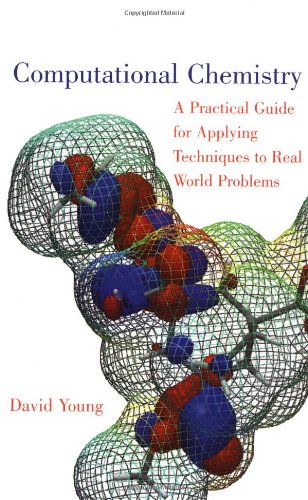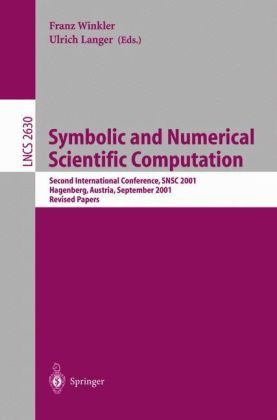David B. Cook9780198501145, 0198501145
Table of contents :
Cover of Dover edition……Page 1
Title page……Page 3
Date-line……Page 4
Dedication……Page 5
Preface……Page 7
CONTENTS……Page 11
1.1 Introduction……Page 25
1.2 Time-independent Schrodinger equation……Page 28
1.3 The Born-Oppenheimer model……Page 30
1.4 The Pauli principle……Page 32
1.5 The orbital model……Page 34
1.6 The determinantal method……Page 37
1.7 Physical interpretation……Page 39
1.8 Non-determinantal forms……Page 41
1.9 The variation principle……Page 42
1.10 Summary……Page 45
1.A Atomic units……Page 47
1.B.2 The Hamiltonian……Page 49
1.B.3 Many-electron wavefunctions……Page 50
1.B.5 Linear expansions for the spatial orbitals……Page 51
1.B.6 Primitive Gaussians……Page 52
1.B.7 Single determinant energy expression……Page 53
1.B.8 Notation for repulsion integrals……Page 55
1.B.10 Basis function repulsion integrals……Page 56
2.1 Introduction……Page 58
2.2 The variational method……Page 59
2.3 The differential Hartree-Fock equation……Page 60
2.4 Canonical form……Page 68
2.5 Orbital energies……Page 69
2.6 Physical interpretation……Page 71
2.7 Direct parametric minimisation……Page 72
2.8 Summary……Page 73
2.A.1 Introduction……Page 74
2.A.2 The normalisation integral……Page 76
2.A.3 One-electron terms……Page 80
2.A.4 Two-electron terms……Page 84
2.A.5 Summary……Page 89
3.1 Introduction……Page 94
3.2 Notation……Page 96
3.3 The expansion……Page 97
3.5 The numerator: Hamiltonian mean value……Page 99
3.6 The denominator: normalisation condition……Page 103
3.7 The Hartree-Fock equation……Page 104
3.8 “Normalisation”: the Lagrangian……Page 105
3.9 Preliminary summary……Page 106
3.10 Some technical manipulations……Page 107
3.11 Canonical orbitals……Page 111
3.12 The total energy……Page 113
3.13 Summary……Page 114
3.A Atomic orbitals……Page 116
3.B Charge density……Page 118
3.C.1 Mathematical properties……Page 121
3.C.2 Physical interpretation……Page 123
3.C.3 Supermatrices……Page 124
3.D.4 Lowest state of a given symmetry……Page 126
3.E.5 Orthogonal invariance……Page 128
3.E.6 Koopmans’ theorem……Page 129
3.E.7 Localised orbitals……Page 130
3.E.8 “Zeroth-order” perturbed orbitals……Page 131
4.1 Introduction……Page 132
4.3 Closed-shell expansion……Page 133
4.4 The closed-shell “HF” equation……Page 134
4.5 Closed-shell summary……Page 137
5.1 Preview……Page 138
5.2 Vectors, matrices and arrays……Page 139
5.3 The implementation: getting started……Page 145
5.4 The implementation: repulsion integral access……Page 161
5.5 Building a testbench: conventional SCF……Page 171
5.6 Another testbench: direct SCF……Page 178
5.8 What next?……Page 186
5.A.1 Introduction……Page 188
5.A.2 The problem……Page 189
5.A.3 The solution……Page 190
5.A.4 Implementation……Page 191
5.A.5 Other diagonalisation methods……Page 194
5.B.6 Introduction……Page 195
5.B.7 Functions of a matrix……Page 197
5.B.8 Implementation……Page 198
5.C getint and data for $H_2O$……Page 201
5.D Coding the standard index loops……Page 205
6.1 Introduction……Page 209
6.2 Versions: conditional compilation……Page 210
6.3 Improved diagonalisation……Page 216
6.4 Simple interpolation……Page 219
6.5 Improving the formation of G(R)……Page 221
6.6 Summary……Page 223
7.1 Introduction……Page 225
7.2 Basis functions……Page 226
7.3 AOs and atom-centred-functions……Page 227
7.4 Multi-dimensional integral evaluation……Page 229
7.5 Molecular integrals over STOs……Page 230
7.6 Basis functions of convenience……Page 239
7.7 Gaussian basis functions……Page 240
7.8 The contraction technique……Page 258
8.1 Introduction……Page 260
8.2 Data structures……Page 261
8.3 Normalisation……Page 264
8.4 Overview; the general structure……Page 267
8.5 Complex code management: the WEB system……Page 273
8.6 A working WEB……Page 280
8.7 Some comments on the WEB……Page 290
8.8 The full integral codes……Page 291
8.A Source for the WEB of fmch……Page 292
9.2 A storage algorithm……Page 298
9.3 Implementation: putint……Page 300
9.4 A partner for putint; getint……Page 306
9.5 Conclusion……Page 308
10.1 Introduction……Page 309
10.2 Virtual orbitals in practice……Page 310
10.3 The virtual space in LCAO……Page 315
10.4 Conclusions……Page 319
10.A.2 Perturbation theory……Page 320
10.A.3 Perturbation theory for matrix equations……Page 325
11.1 Existing software……Page 327
11.2 Why ratfor?……Page 330
11.3 The Revision Control System: RCS……Page 332
11.A.2 Introduction……Page 334
11.A.3 Getting started with RCS……Page 335
12.1 Introduction……Page 338
12.2 Choice of constraints……Page 339
12.3 Organising the basis……Page 341
12.4 Integrals over the spin-basis……Page 342
12.5 Implementation……Page 344
12.6 J and K for GUHF……Page 345
12.7 The GUHF testbench……Page 350
12.8 Interpreting the MO coefficients……Page 353
12.9 DODS or GUHF?……Page 356
12.10 Version 1 of the SCF code……Page 357
12.11 WEB output for function scf……Page 361
12.12 Comments……Page 369
12.A WEB Source for the scf code……Page 370
12.B.1 The block form of the HF matrix……Page 375
12.B.2 Implementation……Page 376
12.C.4 The second variation……Page 387
12.C.5 Special case: a single excitation……Page 389
13.1 Introduction……Page 391
13.2 Densities and spin-densities……Page 392
13.3 Basis representations: charges……Page 393
13.4 Basis-function analysis……Page 396
13.5 A cautionary note……Page 398
13.6 Multi-determinant forms……Page 399
13.7 Implementation……Page 400
14.1 A generalisation……Page 401
14.2 Shells of orbitals……Page 402
14.3 The variational method……Page 404
14.4 A single “Hartree-Fock” operator……Page 407
14.5 Non-orthogonal basis……Page 410
14.6 Choice of the arbitrary matrices……Page 412
14.7 Implementation: stacks of matrices……Page 414
14.A.1 Introduction: optimum single determinant……Page 424
14.A.2 Alternative SCF conditions……Page 426
14.A.3 R matrices as projection operators……Page 427
15.1 Introduction……Page 430
15.2 The ROHF model……Page 431
15.3 Implementation……Page 432
15.4 A WEB for spin-restricted open shell……Page 433
16 Banana skins: unexpected disasters……Page 460
16.1 Symmetry restrictions……Page 461
16.2 Anions……Page 462
16.3 Aufbau exceptions……Page 463
16.4 Summary……Page 465
17.1 Introduction……Page 466
17.2 Symmetry and the HF method……Page 467
17.3 Permutational symmetry of the basis……Page 469
17.4 Implementation……Page 474
17.5 Permutation symmetry: summary……Page 490
18.1 Introduction……Page 491
18.2 Symmetry-adapted basis……Page 494
18.3 Generation of symmetry orbitals……Page 497
18.4 Conclusions……Page 500
19.1 Introduction……Page 501
19.2 Permutations only……Page 504
19.3 Full implementation; linear combinations……Page 513
19.4 Summary……Page 518
19.A.2 Basis-product transformations……Page 519
19.A.3 Density matrix transformations……Page 521
19.A.4 Transformations in the HF matrix……Page 522
19.A.5 Practice……Page 524
20.1 Correlation and the Hartree-Fock model……Page 525
20.2 The configuration interaction method……Page 526
20.3 The valence bond method……Page 527
20.4 Restricted CI……Page 528
20.5 Symmetry-restricted CI……Page 534
20.6 More general CI……Page 536
20.7 Nesbet’s method for large matrices……Page 537
20.8 “Direct” CI……Page 543
20.9 Conclusions……Page 548
20.A The “orthogonal VB” model……Page 549
20.B DCI matrix elements……Page 551
21.1 Non-orthogonality in expansions……Page 554
21.2 Spins and spin functions……Page 555
21.3 Spin eigenfunctions and permutations……Page 559
21.4 Spin-free VB theory……Page 563
21.5 Summary……Page 568
22.1 Introduction: natural orbitals……Page 569
22.2 Paired-excitation MCSCF……Page 572
22.4 Partial Paired-Excitations; GVB……Page 577
22.5 Details.of GVB……Page 580
22.6 Implementation……Page 585
23.1 Introduction……Page 586
23.2 Stationary points……Page 587
23.3 Many shells……Page 589
23.4 Summary……Page 590
24.1 Introduction……Page 591
24.2 Simple orthogonalization……Page 593
24.3 Transforming the Hartree-Fock equation……Page 594
24.4 The pseudopotential……Page 598
24.5 Arbitrariness in the pseudo-orbital……Page 600
24.6 Modelling atomic pseudopotentials……Page 603
24.7 Modelling atomic core potentials……Page 605
24.8 Several valence electrons……Page 608
24.9 Atomic cores in molecules……Page 612
24.10 Summary……Page 613
25.2 Forms for the core potentials……Page 615
25.3 Core potential integrals……Page 619
25.4 Implementation……Page 628
26.1 Introduction……Page 629
26.2 Two forms for the HF equations……Page 630
26.3 Self-consistent perturbation theory……Page 633
26.4 The method……Page 634
26.5 Conclusions……Page 642
27.2 Time-dependent Hartree-Fock theory……Page 645
27.3 Oscillatory time-dependent perturbations……Page 647
27.4 Self consistency……Page 650
27.5 Implementation……Page 651
27.A “Random phase approximation”……Page 653
27.B Time-dependent variation principle……Page 655
28.1 Introduction……Page 657
28.2 Transitions……Page 658
28.3 The transition frequencies……Page 659
28.4 Finite perturbations; oscillations……Page 660
28.5 Stability; the time-independent case……Page 662
28.6 Implementation……Page 663
29.1 Orbital transformations……Page 664
29.2 Strategy……Page 665
29.3 Transformation without sorting……Page 667
29.4 Transformations with sorting……Page 678
29.5 Summary……Page 680
29.A.1 Derivation……Page 681
29.A.2 Implementation……Page 684
30.1 Introduction……Page 695
30.2 Derivatives and perturbation theory……Page 696
30.3 Derivatives of variational solutions……Page 698
30.4 Parameter-dependent basis functions……Page 700
30.5 The derivative of the SCF energy……Page 701
30.6 Derivatives of molecular integrals……Page 705
30.7 Derivatives of non-variational energies……Page 706
30.9 Summary……Page 708
31.1 Introduction……Page 710
31.2 Use of Coulomb’s law……Page 711
31.3 Atomic data……Page 713
31.4 Simulation or calibration?……Page 714
31.5 General conclusions……Page 715
32.1 Introduction……Page 717
32.2 Hohenberg and Kohn’s proofs……Page 719
32.3 Kohn-Sham equations: introduction……Page 724
32.4 Kohn-Sham equations……Page 727
32.5 Non-local operators in orbital theories……Page 729
33.1 A precursor: The Hartree-Fock-Slater model……Page 732
33.2 Implementation of the Kohn-Sham method……Page 734
33.3 The kinetic energy density……Page 739
33.5 Numerical integration of densities……Page 741
33.6 Summary……Page 744
34.1 Non-variational expansions……Page 746
34.2 The pseudospectral method……Page 748
34.3 The discrete variational method……Page 753
35.1 Additional reading……Page 756
35.2 Additional material by ftp……Page 758
Index……Page 761







Reviews
There are no reviews yet.